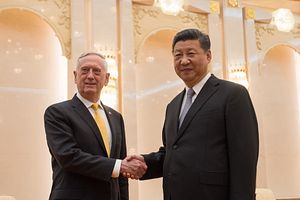Six months after overseeing the release of the Trump administration’s National Defence Strategy – a document that identified China as a revisionist power and competitor of the United States – Jim Mattis went to China.
The US defence secretary’s trip was never going to be a walk in that park, at least not in the way trips to China often had been for his predecessors.
Mattis opened June by vocally condemning China’s militarization of features in the South China Sea before Asia-Pacific security and defense elites gathered at the Shangri-La Dialogue in Singapore.
In May, in retaliation for China’s decision to place missiles on the disputed Spratly Islands and land an H-6K bomber on Woody Island, the United States also decided to withdraw its invitation for China to take part in this summer’s biennial Rim of the Pacific (RIMPAC) multilateral naval exercises.
But as Mattis landed in China, his objective was modest: he had come to talk and, in his own words, to ensure that the US-China relationship remain on “a great trajectory, going in the right direction.”
The trip was Mattis’ first to China since he became Trump’s secretary of defense and came at a time when he appeared to be more isolated from the president’s inner circle than ever before.
In China, Mattis largely maintained a positive tone, with his Chinese counterparts broadly reciprocating. Mattis met with Defence Minister Wei Fenghe and, eventually, with President Xi Jinping.
“This is an important time in the history of China and the United States as we work our way forward,” Mattis told Xi, aware that the United States and China are at a turning point in their relationship.
The disputed waters of the South China Sea remain turbulent, and the issue of Taiwan remains as sharp a wedge as ever. It doesn’t help that declining economic ties amid a spiraling trade war has amplified the countries’ disagreements.
According to senior US officials accompanying Mattis, he did not shy away from confronting the nations’ differences on regional security issues and on the evolution of the military-to-military relationship.
On the South China Sea, Mattis fruitlessly tried to remind Wei of Xi’s pledge in the autumn of 2015, made in the White House Rose Garden alongside US President Barack Obama, to not militarise the Spratly Islands.
China’s position, however, remained uncompromising on issues it considers its core interests, and the reminder of Xi’s broken promise left the Chinese leadership unmoved.
Referring to the South China Sea, Xi was quoted by CCTV as saying that “not a single inch of the territory left behind by our ancestors must be lost, while we are not seeking to take any bit of what belongs to others.”
Mattis’ trip could have gone much worse than it did, but one is left with the sense that the visit did little to divert the United States and China away from a trajectory of increased friction and overt competition.
From Taiwan to the South China Sea to the future of the regional security architecture in Asia, the countries continue to have sharply divergent features. While they remain able to address these disagreements at a high level in face-to-face diplomacy, there’s no sign that either side is willing to compromise.
But beyond this, the trip reveals an underlying gap in the Trump administration’s plan to deal with China. Beyond naming-and-shaming and the modest reputational costs of withdrawing the invitation to participate in RIMPAC, the United States continues to lack an effective mode of imposing sufficient costs on China to alter its behaviour.
Mattis’ trip could have been a dramatic opportunity for the Trump administration to demonstrate that it was ready to take China to task for its rule-breaking behavior, but instead comes off as a missed opportunity.
This article first appeared at the South China Morning Post. It is republished here with kind permission.

































